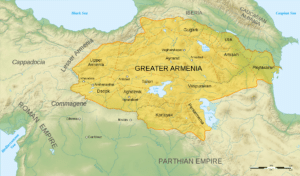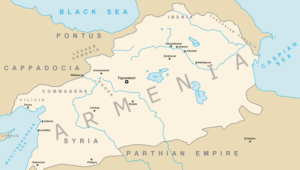
During the late 6th century BC, the first geographical entity that was called Armenia by neighboring populations was established under the Orontid Dynasty within the Achaemenid Empire, as part of the latters’ territories. The kingdom became fully sovereign from the sphere of influence of the Seleucid Empire in 190 BC under King Artaxias I and begun the rule of the Artaxiad dynasty. Armenia reached its height between 95 and 66 BC under Tigranes the Great, becoming the most powerful kingdom of its time east of the Roman Republic.

In the next centuries, Armenia was in the Persian Empire’s sphere of influence during the reign of Tiridates I, the founder of the Arsacid dynasty of Armenia, which itself was a branch of the Parthian Empire. Throughout its history, the kingdom of Armenia enjoyed both periods of independence and periods of autonomy subject to contemporary empires. Its strategic location between two continents has subjected it to invasions by many peoples, including Assyria (under Ashurbanipal, at around 669–627 BC, the boundaries of Assyria reached as far as Armenia and the Caucasus Mountains), Medes, Achaemenid Empire, Greeks, Parthians, Romans, Sasanian Empire, Byzantine Empire, Arabs, Seljuk Empire, Mongols, Ottoman Empire, the successive Safavid, Afsharid, and Qajar dynasties of Iran, and the Russians.
Religion in ancient Armenia was historically related to a set of beliefs that, in Persia, led to the emergence of Zoroastrianism. It particularly focused on the worship of Mithra and also included a pantheon of gods such as Aramazd, Vahagn, Anahit, and Astghik. The country used the solar Armenian calendar, which consisted of 12 months.
Christianity spread into the country as early as AD 40. Tiridates III of Armenia (238–314) made Christianity the state religion in 301, partly, in defiance of the Sasanian Empire, it seems, becoming the first officially Christian state, ten years before the Roman Empire granted Christianity an official toleration under Galerius, and 36 years before Constantine the Great was baptized. Prior to this, during the latter part of the Parthian period, Armenia was a predominantly Zoroastrian country.

After the fall of the Kingdom of Armenia in 428, most of Armenia was incorporated as a marzpanate within the Sasanian Empire. Following the Battle of Avarayr in 451, Christian Armenians maintained their religion and Armenia gained autonomy.
Middle Ages:
After the Sasanian period (428–636), Armenia emerged as Arminiya, an autonomous principality under the Umayyad Caliphate, reuniting Armenian lands previously taken by the Byzantine Empire as well. The principality was ruled by the Prince of Armenia, and recognised by the Caliph and the Byzantine Emperor. It was part of the administrative division/emirate Arminiya created by the Arabs, which also included parts of Georgia and Caucasian Albania, and had its centre in the Armenian city, Dvin. Arminiya lasted until 884, when it regained its independence from the weakened Abbasid Caliphate under Ashot I of Armenia.
The reemergent Armenian kingdom was ruled by the Bagratuni dynasty and lasted until 1045. In time, several areas of the Bagratid Armenia separated as independent kingdoms and principalities such as the Kingdom of Vaspurakan ruled by the House of Artsruni in the south, Kingdom of Syunik in the east, or Kingdom of Artsakh on the territory of modern Nagorno-Karabakh, while still recognising the supremacy of the Bagratid kings.
